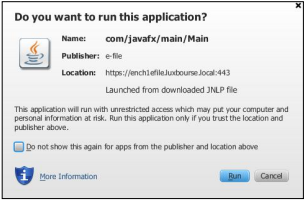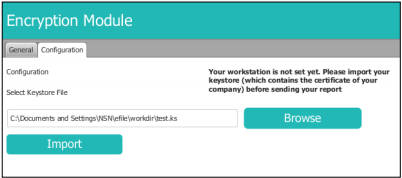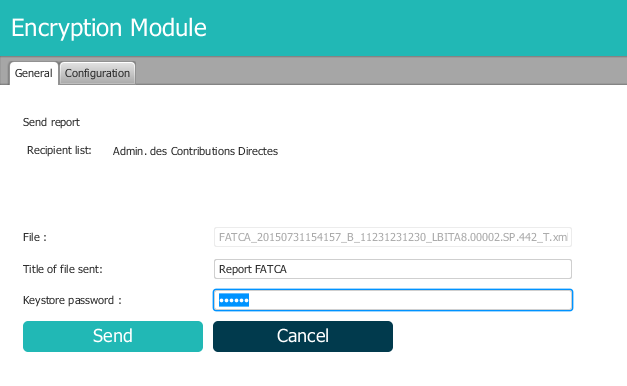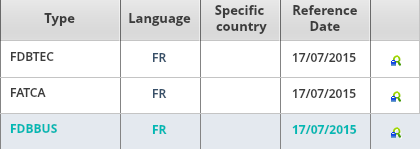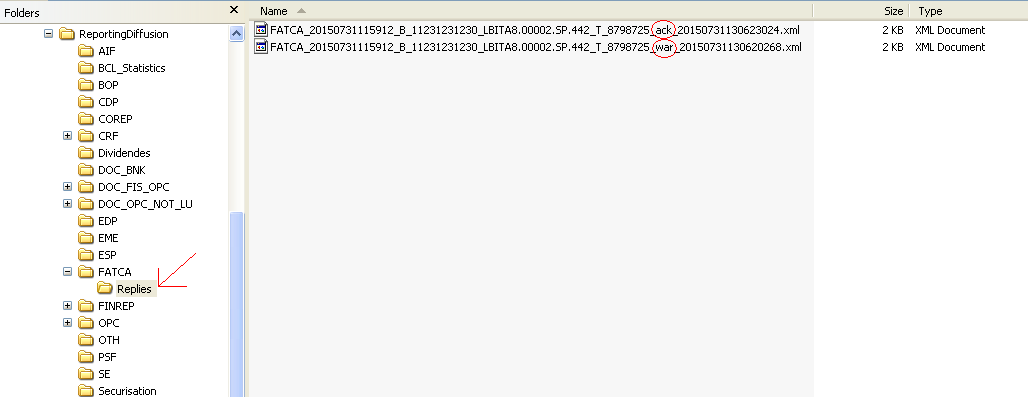Difference between revisions of "FATCA Manual"
| Line 1: | Line 1: | ||
<div style="text-align: right; direction: ltr; margin-left: 1em;">[[Welcome_to_e-file_and_Fundsquare_FAQ|Home page ]][[File:Home.png|Return homepage|link=Welcome_to_e-file_and_Fundsquare_FAQ]] </div> | <div style="text-align: right; direction: ltr; margin-left: 1em;">[[Welcome_to_e-file_and_Fundsquare_FAQ|Home page ]][[File:Home.png|Return homepage|link=Welcome_to_e-file_and_Fundsquare_FAQ]] </div> | ||
<div style="text-align: right; direction: ltr; margin-left: 1em;">[[Manuel FATCA|Français]] [[File:french.jpg|Accéder à la partie française|link=Manuel_FATCA]]</div> | |||
= Naming convention = | = Naming convention = | ||
Revision as of 12:18, 7 August 2015
Naming convention
Report :
FATCA_DateTime_Channel_MatriculeReporter_GIIN_ProdTest.xml
Feedback from ACD :
FATCA_ DateTime_Channel_MatriculeReporter_GIIN_ProdTest_Status.xml
| Code | Definition | Structure | Values |
|---|---|---|---|
| DateTime | Creation date and time | Number(14) | AAAAMMJJhhmmss |
| Channel | Communication channel | Char(1) | B (Bourse) |
| MatriculeReporter | Social Security Identification Number | Number(11) - Number(13) | Code CCSS |
| GIIN | GIIN (Global Intermediary Identification Number ) of the declarer | Char(6).Char(5).Char(2).Number(3) | Code GIIN XXXXXX.XXXXX.XX.XXX |
| ProdTest | Environment type | Char(1) | P = Production
T = Test |
| Status | Response status | Char(3) | Technical Feedback
ACK = File technically received by ACD |
Examples
Report :
FATCA_20150731115912_B_11231231230_LBITA8.00002.SP.442_T.xml
FATCA report created the 31/07/2015 via Bourse’s channel, with CCSS code 11231231230 GIIIN code LBITA8.00002.SP.442, in the test environment.
Feedback from ACD :
FATCA_20150731115912_B_11231231230_LBITA8.00002.SP.442_T_ack.xml
FATCA report created the 31/07/2015 via Bourse’s channel, with CCSS code 11231231230 GIIIN code LBITA8.00002.SP.442, in the test environment and has been received by ACD.
Manual sending
Link to the video tutorial for FATCA report : https://www.e-file.lu/videos/Util_FATCA_Flex_EN.htm
Work in progress, export and import of reports
Work in progress on a report can be saved with the ![]() button. The exported .xml file will be called DRAFT_filename.xml and cannot be uploaded for FATCA filing. It can be imported for later use.
button. The exported .xml file will be called DRAFT_filename.xml and cannot be uploaded for FATCA filing. It can be imported for later use.
The final reported can be saved via the ![]() button. This button will only be available if the green Icon
button. This button will only be available if the green Icon ![]() appears in every section and the report has been completed. The file will be saved in xml format with the required naming convention. It will be saved on your hard drive and is available for sending to the Regulator.
appears in every section and the report has been completed. The file will be saved in xml format with the required naming convention. It will be saved on your hard drive and is available for sending to the Regulator.
The ![]() button allows you to upload an existing report in .xml from your network or
harddrive into the report generator.
button allows you to upload an existing report in .xml from your network or
harddrive into the report generator.
Transmission with the Report Generator
Setup of the e-file v2 encryption module v2
A completed report can be sent with the ![]() button. Java version 1.7.55 is a prerequisite for the installation of the e-file v2 encryption module.
button. Java version 1.7.55 is a prerequisite for the installation of the e-file v2 encryption module.
When the ![]() button is used for the first time, a Java application will be downloaded (.jnlp) in order to install the encryption module locally on your computer.
button is used for the first time, a Java application will be downloaded (.jnlp) in order to install the encryption module locally on your computer.
Please hit ![]() when the following window appears on your screen in order to launch the encryption module.
when the following window appears on your screen in order to launch the encryption module.
Warning: It is possible that the pop up blocker prevents that the .jnlp file is downloaded. Please check
with your IT to allow pop ups from https://www.e-file.lu/ .
The encryption module has to be configured when it is used for the first time (or after each Java
update). The path to the keystore has to be selected with the ![]() button and the key (locally or on a server) will have to be imported with the
button and the key (locally or on a server) will have to be imported with the ![]() button :
button :
After the import of the key, the access to the keystore is saved and does not have to be reconfigured
in the future. You will be redirected to the sending screen and reports can now be sent with e-file v2.
In order to be more user friendly and to speed up the sending process, the encryption module runs as
a back ground process on your desktop. In order to end the process, right click on the icon in the
taskbar and select “Close encryption module” :
After the installation of the encryption module on your desktop, reports can be sent from the Report
Generator with the ![]() button. In the following window, the file name is automatically
generated and compliant to the ACD naming convention :
button. In the following window, the file name is automatically
generated and compliant to the ACD naming convention :
After entering a name for the sending (this name will also be used for search queries) and entering the
keystore password, the report can be sent with the ![]() button. A popup window will confirm the transmission.
button. A popup window will confirm the transmission.
Automatic Sending with the Sending Service
In order to send reports with the Sending Service, the following components have to be installed on your desktop:
- Java version 1.6.0.14 or higher
- Sending service version 3.3.6 or higher
Access to the Sending Service
The Sending Service is accessible with the file explorer and visible as a folder including subfolders :
The standard file structure includes a «FATCA» subfolder (by default, a subfolder for each type of reporting is included).
Sending frequency
During the setup of the sending service, the sending frequency can be individually set for each subfolder by your e-file administrator within the setup file. The default sending frequency is every 30 minutes but it can be tailored according to your needs.
Report transmission
In order to send a report with the Sending Service, the exported .xml report has to be copied into the …/ServiceDeposant/ReportingDiffusion/FATCA subfolder.
Files created by the Sending Service
During and at the end of the sending, the Sending Service generates various files in the subfolder that
has been used for the sending. Three type of files are generated:
- .trt file : indicates the start of the transmission
In order to be able to send the original file, the Sending Service transforms the latter into a .trt file and
adds a timestamp. Eg «OriginalName.xml» is transformed into OriginalName.xml.timestamp.trt:
FATCA_20150731115912_B_11231231230_LBITA8.00002.SP.442_T.xml becomes
FATCA_20150731115912_B_11231231230_LBITA8.00002.SP.442_T.xml_20150731122616366.trt
- .acq file : the transmission has been successfully completed
Example of a successful transmission :
Before the transmission :
- .err file : indicates that an error has occurred during the sending
The error file contains technical messages designed to help find the root cause of the error, eg naming errors.
Transmission follow up
Get the feedbacks
Manual access
First connect on https://www.e-file.lu/e-file with your credentials.
Select the "Document management" module as follow :
Select "Transmission follow up" tab :
The search can be defined between 2 dates and will display all the reports sent during that period.
Each report has a status to have a quick overview of your sendings.
- "Transmitted" means that the report is currently dispatched to the ACD.
- "Feedback Received" means that at least one feedback has been received. It also means that the ACD was able to read your report.
- "To validate" means that the report needs to be validated by the declarant on E-file V2. This is a really specific case.
To see the reports and its feedback, click on the blue icon on the right.
The files are displayed with a type:
- FATCA = Original report
- FDBTEC = Technical feedback
- FDBBUS = Business feedback
To read one of these files, click on the green icon on the right.
As the document is encrypted it will launch our encryption module V2.
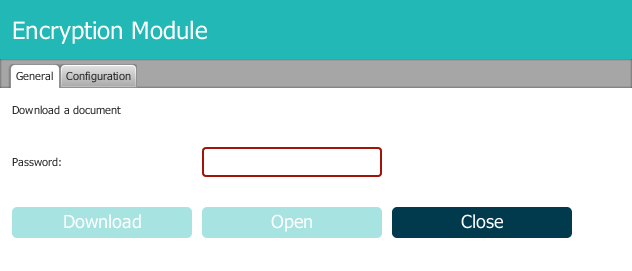
Finally the keystore password is requested to either save the file or directly open it.
Access from Sending Service
ACD's feedbacks can be found in the sub-folder "Replies" from the following path .../ServiceDeposant/ReportindDiffusion/FATCA/Replies/.
Each feedback has a specifical status (see #Naming_convention : Status) which can be seen in the file name (ex : ack).
The "Replies" folder is created upon feedback receipt. Please check the Sending Service's configuration whether it cannot be found. In the configuration file, the variable corresponding to "Configuration of connection for feedback" and the the one corresponding to "Configuration of connection for authority acknowledgement" should be set to "up".
FATCA FAQ
What is the AEOI reference ?
The AEOI reference is a unique reference that needs to be set up for your report. It's a free text you can fill with the text/number of your choice. It is used to identify reports if you need to make a reference.
How to modify an existing report ?
In order to modify an existing report the Report Generator's form has to be completed with the new information. The type of modification to apply is set up in the "Reporting FI" section in "Document Specification" and in "Reporting Group" section in "Account Report" when clicking ![]() .
.
The different types are the following :
- FATCA1 : Initial sending. The file contains only new information
- FATCA2 : Asked modifications. The file contains only corrections asked by american's authorities (IRS)
- FATCA3 : Cancellations. The file contains only cancellations concerning previously changed information
- FATCA4 : Modifications. The file contains only corrections concerning the previously changed information on declarer's initiative
To chose the report to modify, its reference has to be entered in the document reference ID to correct and message reference ID to correct.
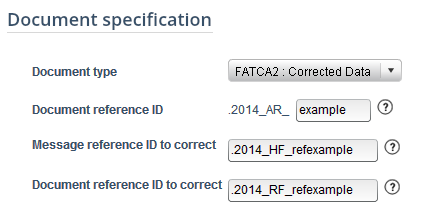
Why the GIINs do not appear on the form ?
To register your GIINs the contact form of our Client Service has to be fill up.
After the registration of your GIINs you will receive a confirmation mail within few days, if you haven't received the email yet please contact fatca_onboarding@fundsquare.net.
Error message : The process takes too much time. Please restart the encryption module.

The error message occurs when the encryption module is not started in time.
Please check that the pop up are enable for the site https://www.e-file.lu.
When clicking the "Transmission" button the file EfileCrypto.jnlp should be downloaded in order to launch the encryption module. You have to open this file with Java Web Start Launcher to run the module.
Message : Waiting files to transmit...
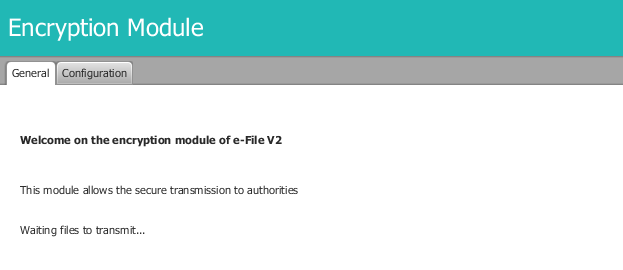
This error might occur when there is a connection problem between your proxy and the encryption module V2.
Close the encryption module 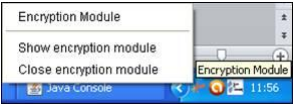 and open the Java console (See http://www.e-file.lu/wiki/index.php/Encryption_Module#Show_the_console_in_case_of_other_Java_issue)and check if there is an error 407.
In that case the solutions to resolve this problem are the following :
and open the Java console (See http://www.e-file.lu/wiki/index.php/Encryption_Module#Show_the_console_in_case_of_other_Java_issue)and check if there is an error 407.
In that case the solutions to resolve this problem are the following :
- Add the group "NoAuthenticated exception group" to your proxy for www.e-file.lu
- By-pass the proxy for the communication with www.e-file.lu
For more information please call the Helpdesk.
